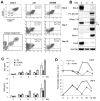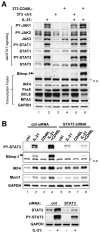IL-21 and CD40L synergistically promote plasma cell differentiation through upregulation of Blimp-1 in human B cells
- PMID: 23325890
- PMCID: PMC3563840
- DOI: 10.4049/jimmunol.1201678
IL-21 and CD40L synergistically promote plasma cell differentiation through upregulation of Blimp-1 in human B cells
Abstract
After undergoing Ig somatic hypermutation and Ag selection, germinal center (GC) B cells terminally differentiate into either memory or plasma cells (PCs). It is known that the CD40L and IL-21/STAT3 signaling pathways play critical roles in this process, yet it is unclear how the B cell transcription program interprets and integrates these two types of T cell-derived signals. In this study, we characterized the role of STAT3 in the GC-associated PC differentiation using purified human tonsillar GC B cells and a GC B cell-like cell line. When primary GC B cells were cultured under PC differentiation condition, STAT3 inhibition by AG490 prevented the transition from GC centrocytes to preplasmablast, suggesting that STAT3 is required for the initiation of PC development. In a GC B cell-like human B cell line, although IL-21 alone can induce low-level Blimp-1 expression, maximum Blimp-1 upregulation and optimal PC differentiation required both IL-21 and CD40L. CD40L, although having no effect on Blimp-1 as a single agent, greatly augmented the amplitude and duration of IL-21-triggered Jak-STAT3 signaling. In the human PRDM1 locus, CD40L treatment enhanced the ability of STAT3 to upregulate Blimp-1 by removing BCL6, a potent inhibitor of Blimp-1 expression, from a shared BCL6/STAT3 site in intron 3. Thus, IL-21 and CD40L collaborate through at least two distinct mechanisms to synergistically promote Blimp-1 activation and PC differentiation.
Figures





Similar articles
-
Constitutive CD40L expression on B cells prematurely terminates germinal center response and leads to augmented plasma cell production in T cell areas.J Immunol. 2010 Jul 1;185(1):220-30. doi: 10.4049/jimmunol.0901689. Epub 2010 May 26. J Immunol. 2010. PMID: 20505142 Free PMC article.
-
Regulation of B cell differentiation and plasma cell generation by IL-21, a novel inducer of Blimp-1 and Bcl-6.J Immunol. 2004 Nov 1;173(9):5361-71. doi: 10.4049/jimmunol.173.9.5361. J Immunol. 2004. PMID: 15494482
-
Augmented antibody response with premature germinal center regression in CD40L transgenic mice.J Immunol. 2010 Jul 1;185(1):211-9. doi: 10.4049/jimmunol.0901694. Epub 2010 May 26. J Immunol. 2010. PMID: 20505144
-
Regulatory mechanisms that determine the development and function of plasma cells.Annu Rev Immunol. 2003;21:205-30. doi: 10.1146/annurev.immunol.21.120601.141138. Epub 2001 Dec 19. Annu Rev Immunol. 2003. PMID: 12524387 Review.
-
Survival and proliferation factors of normal and malignant plasma cells.Int J Hematol. 2003 Aug;78(2):106-13. doi: 10.1007/BF02983377. Int J Hematol. 2003. PMID: 12953803 Free PMC article. Review.
Cited by
-
Plasma cell alloantigen ENPP1 is expressed by a subset of human B cells with potential regulatory functions.Immunol Cell Biol. 2016 Sep;94(8):719-28. doi: 10.1038/icb.2016.31. Epub 2016 Mar 31. Immunol Cell Biol. 2016. PMID: 27029896
-
Modulating cholesterol-rich lipid rafts to disrupt influenza A virus infection.Front Immunol. 2022 Sep 13;13:982264. doi: 10.3389/fimmu.2022.982264. eCollection 2022. Front Immunol. 2022. PMID: 36177026 Free PMC article. Review.
-
STAT3 signaling in immunity.Cytokine Growth Factor Rev. 2016 Oct;31:1-15. doi: 10.1016/j.cytogfr.2016.05.001. Epub 2016 May 9. Cytokine Growth Factor Rev. 2016. PMID: 27185365 Free PMC article. Review.
-
Flow Cytometric Methods for the Detection of Intracellular Signaling Proteins and Transcription Factors Reveal Heterogeneity in Differentiating Human B Cell Subsets.Cells. 2020 Dec 8;9(12):2633. doi: 10.3390/cells9122633. Cells. 2020. PMID: 33302385 Free PMC article.
-
Distinct modes of action of CD40L and adaptive cytokines IL-2, IL-4/13, IL-10 and IL-21 on rainbow trout IgM+ B cells.Dev Comp Immunol. 2020 Oct;111:103752. doi: 10.1016/j.dci.2020.103752. Epub 2020 May 22. Dev Comp Immunol. 2020. PMID: 32447012 Free PMC article.
References
-
- Shapiro-Shelef M, Calame K. Regulation of plasma-cell development. Nat Rev Immunol. 2005;5:230–242. - PubMed
-
- Oracki SA, Walker JA, Hibbs ML, Corcoran LM, Tarlinton DM. Plasma cell development and survival. Immunol Rev. 2010;237:140–159. - PubMed
-
- Kallies A, Hasbold J, Fairfax K, Pridans C, Emslie D, McKenzie BS, Lew AM, Corcoran LM, Hodgkin PD, Tarlinton DM, Nutt SL. Initiation of plasma-cell differentiation is independent of the transcription factor Blimp-1. Immunity. 2007;26:555–566. - PubMed
-
- Goodnow CC, Vinuesa CG, Randall KL, Mackay F, Brink R. Control systems and decision making for antibody production. Nat Immunol. 2010;11:681–688. - PubMed
Publication types
MeSH terms
Substances
Associated data
- Actions
Grants and funding
LinkOut - more resources
Full Text Sources
Other Literature Sources
Miscellaneous

